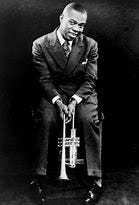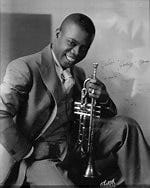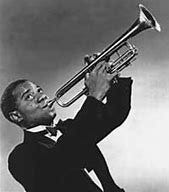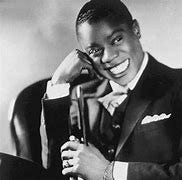There was, first, the man. Self-assured, fully alive, buoyant and exuberant, with that relentlessly broad and beaming smile.
What a fertile mind! Capaciously aware, imaginative, quick – always innovating, inventing, creating.
What a big-hearted personality! Just listen to him talk: “You’re a swell cat.” “You’re a wonder.” “We’re chummy.” “We’re kicks to each other.” “We’ve got get-up-and-go.” “We’re thrilled to the gills.” “Let’s keep the ball rolling.” “You appreciate our every efforts.” “You knock me out.” “Swing it!”
All his life, Louis Armstrong felt that his dirt-poor childhood was “the very best deal” – filled with his mother’s great confidence in him and with his neighbors’ love, joy, and inspiration.
There was, second, the performer. He held nothing back from his audiences. He made people weep, he made people laugh, he made people shake their heads in wonder. He filled his audience with the same spirit that was filling him, and from one end of the club or hall to the other, people’s whole beings soared. He drew people into a heightened and even sublime space and, most frequently, into his own profound sense of joy.
Third, there was the musical genius. At least six great songs from the 1920s still resonate. Try playing his 1927 songs “Heebie-Jeebies” or “Hotter Than That” and not get up and dance. Try listening to his 1927 “Potato Head Blues” or his 1928 “Weather Bird” and not savor the virtuosity. Try listening to him sing and play his trumpet in his 1929 “When You’re Smiling” and not let joy fill your being.
His 1928 “West End Blues” remains electrifying and remains the finest song he ever produced. With this song, jazz music arrived as an art form, equal to the highest orders of the world’s best music, with the dazzling opening fanfare, Earl Hines with his own genius on the piano, Louis’s heart-warming call-and-response with the clarinet, his wistful and lovely crooning, his vaulting upward in another horn solo, and his descending into the satisfying conclusion.
No one played the trumpet better. No one better understood the full power of sound. And he sang in everything from a light tenor to his jive talk to a low growl. He made a telling statement with every solo, and each song was a magnificent innovation.
Armstrong embroidered rhythms within rhythms as he alternated and blended power and grace. He grabbed one element from a melody or a rhythm and varied it, exaggerated it, sped it up. He built the beats, molded the beats, and made the beats flow into one unified tempo.
Such gifts, such mastery, such brilliance. His technical dexterity was astounding. His tone was electrifying. And his sense of harmony was superb. And he did it all with that deep feeling, that honest feeling – upbeat, festive, happy, fun, with a sweet lilt to it, and yet intense, even rough, and with heat and fire and the sharp sting of a realism he learned the hard way.
Fourthly, lastly, ultimately, there is Louis Armstrong the figure of global cultural history.
When he arrived on the musical scene, Americans and Europeans were still listening to the oopmah and ricky-tick of choppy two-beat syncopation.
He grew up with music with roots that reached back into the heart of Africa, back into the call-and-response of slaves – “Go down, Moses” – and back into the work songs of freedmen and freewomen, including the songs of his relatives who worked on the banana wharves of Louisiana.
In Louisiana alone, these strains of music mingled with strains of the mixed-race Creoles, with their sheet music (waltzes and ragtime) and their training in the European skills of notes, scales, keys, and chords. In New Orleans alone, African and Caribbean frenzied chants and swaying to the rhythm – found especially in the Old Sanctified Churches – mingled with the French, Spanish, and British instrumental music of the cornet, woodwinds, bass, and bugle.
This is the New Orleans in which Louis grew up. Louis as a child and youth joined in ratty brass bands, playing for pennies on the streets of New Orleans.
In the Sanctified Church, where the parishioners sang and danced with their whole bodies, Louis learned to get the rhythm and then freely interpret it. In church and in his street band and at the law parties and in the dance halls of New Orleans, Louis learned to expect interaction or “dialogue”, to anticipate it, to stay open to it.
By the time he arrived in Chicago in 1922, Armstrong knew how to tap into communal emotion and rhythm and then spontaneously express his individual voice. He could interpret each phrase in a way that made it personal. He was a master improviser.
In Chicago between 1922 and 1929, Armstrong colored and embellished precise, robust, passionate music – music with superior notes forming superior lines, combined with that high quality of tone and a sure sense of swing.
Nihilists and cynics still view the drunk and desolate Scott and Zelda Fitzgerald as the epitome of the “Lost Generation” born from 1883 to 1901. But “lost” has always been an exaggeration – too severe a judgment and one that causes us to miss their achievement and their legacy. They weren’t the Lost Generation but the Jazz Generation, and the most exemplary figure of the Jazz Age– the one indispensable representative of their generation in the 1920s – was Louis Armstrong.
Louis Armstrong taught us not only how to sing and to swing but how to live. “What we play is life,” the man observed. “You blow who you is.”
A century later, Satchmo is still calling us toward the light, up to that heightened sense of life, and, through all the sorrow and adversity we may experience, into that transcendent and existential joy.









I so enjoyed this. Your love and appreciation for Louis Armstrong's music just shines through. What a marvellous tribute. When I was a child my dad had the album "I've Got The World On A String" and I vividly remember the cover. He had such a unique style and voice. I love the song "Shadrack", and also his duet with Streisand in the film "Hello Dolly". Pure sunshine. Thank you for this Mike, I am going to look up some of the tracks you mention.
Hi Mike. I've missed your historical pieces while I've been away for a bit! They are my favourite. Happy to be catching up.